Motorola Moto G Review
by Brian Klug on December 18, 2013 2:00 PM EST- Posted in
- Smartphones
- Motorola
- Mobile
- *VA
- Cortex A7
- snapdragon 400
- Moto G
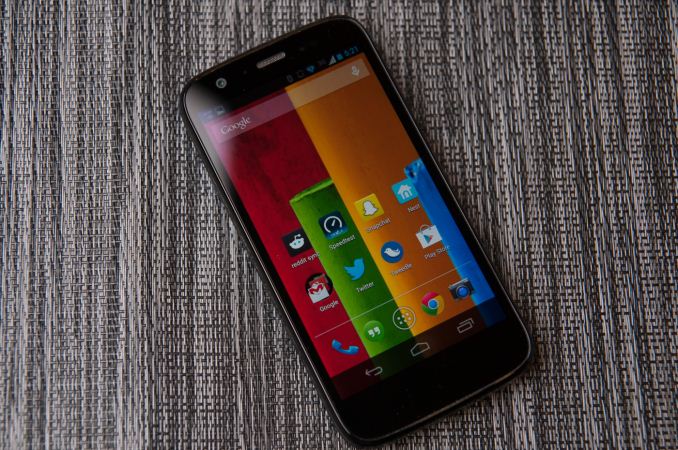
I like what the new Motorola is doing. It seems like an eternity ago, but I remember when phone launches with Motorola meant a variety of variants all with their own idiosyncrasies. Since re-launching itself, Motorola has launched just two new lines of device – the higher end Moto X, and its mass-market cousin, the Moto G which we’re taking a look at. That’s a bit of a simplification, as Motorola is still selling five Droid-branded handsets, but it’s a huge consolidation that’s much easier to follow.
The Moto G’s goal is pretty simple – to deliver an affordable smartphone experience that doesn’t make any sacrifices in something close to the Moto X’s form factor. It’s an ambitious goal that goes right after some of the largest growth segments for smartphones internationally. There’s a ton of competition at the top, it’s somewhere in the middle that’s arguably more interesting right now.
G is a popular character right now, LG was arguably first to lay claim to it with its Optimus G, G Pro, G2, and now G Flex brands, so it’s kind of interesting to see Motorola also lay claim to G with the Moto G. Absent any guidance what G actually stands for, I’m going to take a nod from lens reviewer Ken Rockwell and say that G stands for “Gelded” since the Moto G is really a pared down Moto X, but I wouldn’t attach any real negative connotation to the word. The form factor is largely the same, where the Moto G moves down a notch versus the X is in its camera, display size and tech, cellular connectivity, size (it’s slightly bigger), and of course the lack of active display or always on voice activation features. Like any product, it’s just a different set of tradeoffs, this time more optimized for cost.

My T-Mobile Motomaker Moto X (top), Moto G with turquoise back shell
Before I started working on the Moto G, I switched back to the Moto X for a while to refresh my comparison point, right after it got the 4.4 update. Motorola let me build a blue with yellow accents Moto X from Motomaker since I recently switched to T-Mobile and my previous device was locked to AT&T. The comparison point helped me really feel out the physical differences between the Moto X and Moto G. You can tell that the Moto G is slightly thicker almost immediately, the changes in width, height, and mass don’t really stick out as much. I can’t put my finger on it but the curve of the G seems slightly less pronounced as well, although the G is still comfortable to hold. I won’t bore you any further, but the dimensional differences really aren’t that noticeable between the two, I don’t feel like the Moto G’s in hand feel is a regression at all versus the excellent Moto X.
| Moto X | Moto G | |
| SoC |
Qualcomm Snapdragon S4 Pro (MSM8960Pro) 2x Krait 300 at 1.7 GHz Adreno 320 at 400 MHz Motorola X8 System (SoC+NLP Processor+Contextual Processor) |
Qualcomm Snapdragon 400 (MSM8x26) 4x ARM Cortex A7 at 1.2 GHz Adreno 305 at 450 MHz |
| Display | 4.7-inch AMOLED (RGB) 1280x720 | 4.5-inch LCD (RGB) 1280x720 |
| RAM | 2GB LPDDR2 | 1 GB LPDDR2 |
| WiFi | 802.11a/b/g/n/ac, BT 4.0 | 802.11b/g/n, BT 4.0 |
| Storage | 16 GB standard, 32 GB online, 2 years 50 GB Google Drive | 8/16 GB, 2 years 50 GB Google Drive |
| I/O | microUSB 2.0, 3.5mm headphone, NFC, Miracast | microUSB 2.0, 3.5mm headphone |
| OS | Android 4.4 | Android 4.3, 4.4 Early 2014 |
| Battery | 2200 mAh, 3.8V, 8.36 Whr | 2070 mAh, 3.8V, 7.9 Whr |
| Size / Mass | 65.3 x 129.3 x 5.6-10.4 mm, 130 grams | 65.9 x 129.9 x 6.0-11.6 mm, 143 grams |
| Camera |
10 MP Clear Pixel (RGBC) with 1.4µm pixels Rear Facing 2 MP 1080p Front Facing |
5 MP w/AF, LED Flash 1.3 MP front facing |
| Price | $199 (16 GB), $249 (32 GB) on 2 year contract | $179 (8 GB), $199 (16 GB) no contract |
If you’ve held the Moto X, the Moto G is immediately familiar. For those that haven’t, the two share what’s probably the best balance of size and form factor among Android handsets right now – Moto G is just a bit thicker around the waist.
On the front the Moto G eschews the “magic” fused glass-plastic top layer. For those unaware, one of the standout features of the Moto X was this seamless (well, relatively seamless) transition from glass to plastic along the edge, which really did make it more comfortable to use. Moto G uses the more pragmatic lip and sunken glass approach, and the sample I was provided has a bit of a gap between the two where dust can gather and show. Not a big deal but worth noting as one of the few visible differences. The Moto G still does have some nice lips that prop the display up so you can lay it display-first on a flat surface without worrying about scratching the display.
The Moto G uses the same button and port placement as the Moto X, which I won’t go over. The buttons feel nice and solid as well, not cheap and flimsy. The speakerphone grille moves to the opposite side, but camera and flash positions remain unchanged. The motorola logo and accompanying dimple also don’t go away.
Impressively, Moto G also doesn’t eschew dual microphones for in-call background noise cancelation. There’s a primary microphone at the bottom, and secondary up top. Moto X had a bottom front, bottom back, top side arrangement, so technically Moto G has one fewer microphone, but having dual mic noise suppression is a noteworthy feature at this price point.
The most dramatic change between the two of course is the removable back door, which doesn’t work so much as a door for the battery as it does gate access to the microSIM slot and add an opportunity for adding a touch of customization with a colored or flip shell. As an aside, it’s odd to me that the Moto X embraced nanoSIM (4FF) yet the Moto G that launches after it goes with microSIM (3FF). It’s possible some of the operators or markets Motorola has in mind for the Moto G haven’t yet made nanoSIMs readily available. There’s a big sticker on the back noting that the battery isn’t replaceable, I’m reminded of the Droid 4 which also included a removable back and a big sticker, but no removable battery.
Motorola sent a turquoise colored snap-on shell in addition to a blue flip shell to check out on the Moto G. By default the phone comes with a black shell, but there are six different color shells you can choose from, in those two (flip and non-flip) varieties. I appreciate how much even something like this helps differentiate the Moto G versus competition that comes in at best maybe two or three colors. The materials, fit, and finish on the two snap covers I was sent seem excellent. I have no complaints, there’s no creaks or gaps to speak of. Shells run $14.99, flip shells cost a twenty bucks more at $34.99.
The flip cover nails it though, there’s a magnet inside to both keep the cover shut and in place when closed, and another ostensibly for signaling open and closed status – Moto G turns on automatically when opened, and shuts off when closed. Those two features should be requisite for anyone even thinking of bundling a flip cover as a first party accessory at this point, and I’m impressed to see them on this device at that price point.
Inside the relatively small Moto G box you don’t get much in the way of extra stuff. There’s no bundled USB wall charger or pack-in headphones, just a USB cable. I’m awash with USB chargers so I don’t mind OEMs saving the extra few dollars by not including an extra one, in the case of Moto G at least that savings seems to actually get passed on to the customer. I’ll talk about it in the charging section but Moto G seems well behaved with a variety of USB power sources, thankfully.
Moto G doesn’t try to push industrial design somewhere crazy, and obviously at the price point that it’s coming in at, it can’t really afford to. Solid execution which doesn’t deviate a lot from Moto X and good overall construction are the real highlights.


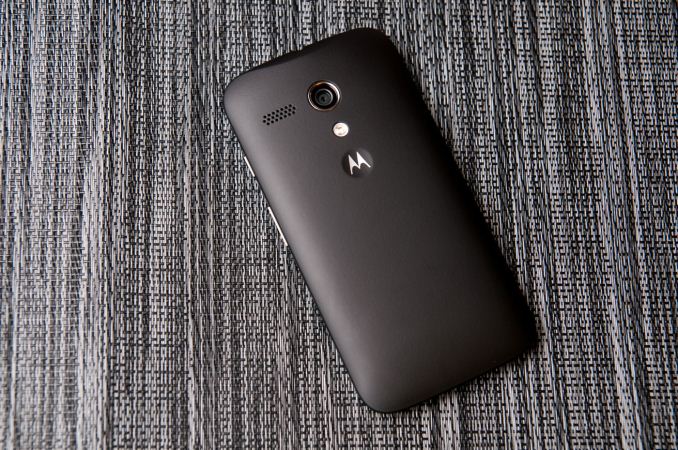
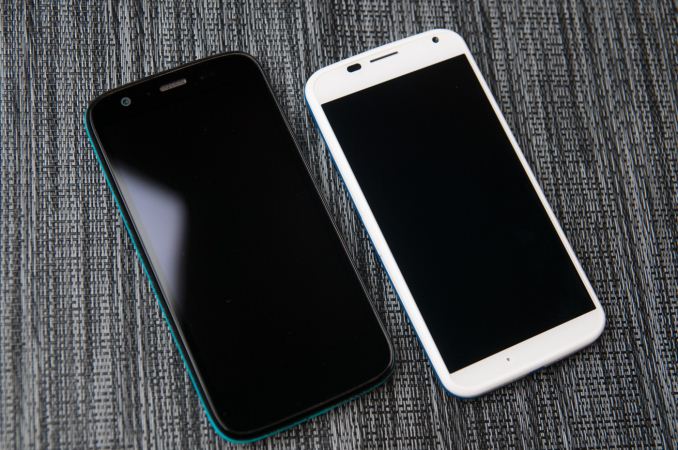






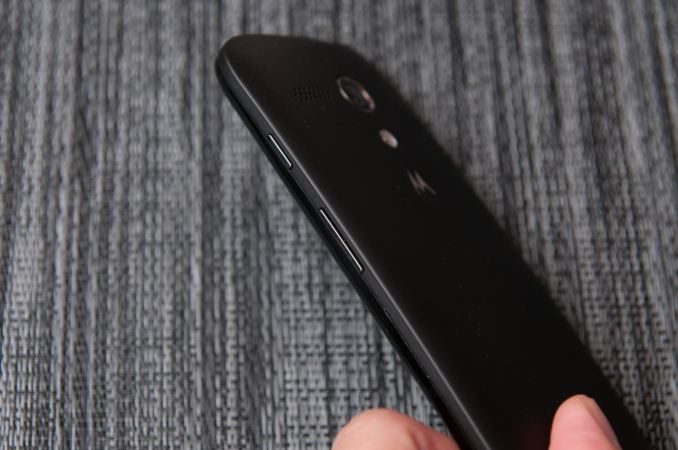
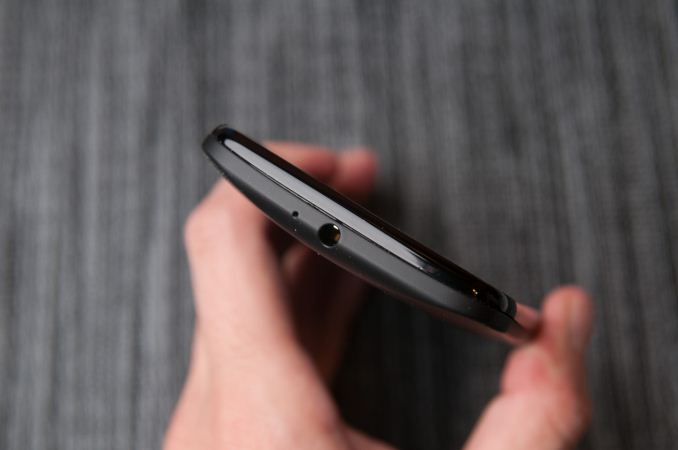
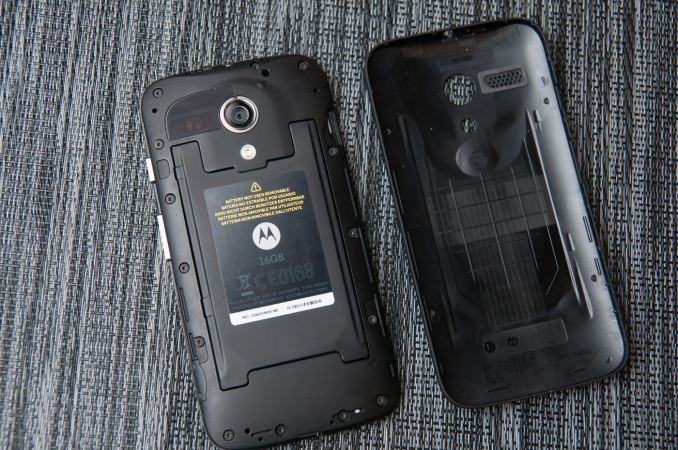
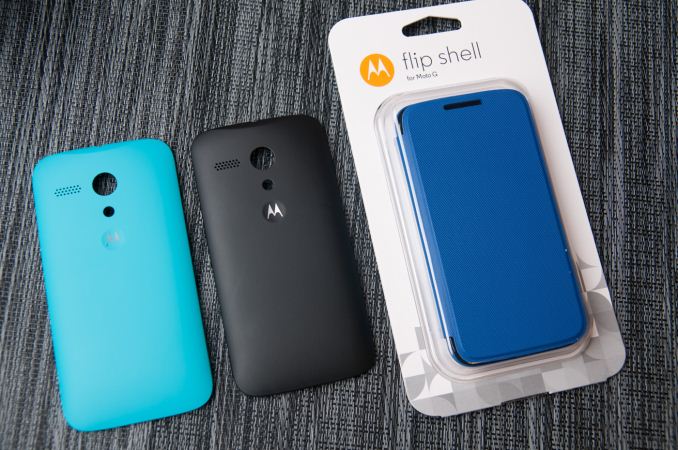
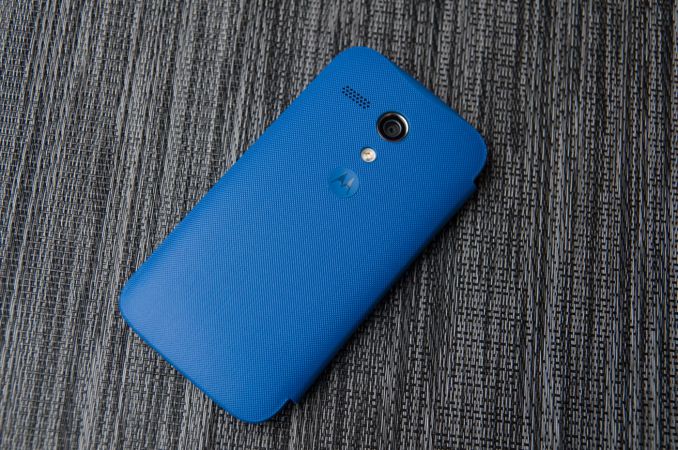








120 Comments
View All Comments
bhima - Monday, December 23, 2013 - link
The market are people that, for example, pay only $25 a month each on a T-mo family plan and they don't want to drop an extra $30 a month for 2 years for a phone, Or sign up for a contract with ATT/Verizon and blow easily $60+ a month. 500mb of data at HSPA+ speed (9mbps in my area) with no overage charge, unlimited talk and text for $25 a month makes this phone a huge winner to those willing to look for a good experience without burning a hole in your wallet.teiglin - Wednesday, December 18, 2013 - link
Every time I read reviews of this I'm surprised at how closely MSM8x26 performs to flagships from as recently as last year. Obviously it isn't really in the running compared to 8974, Apple A7, Exynos 5250, etc., much less APQ8064, so I think this says more embarassing things about companies that shipped quad-A9 flagships in mid-to-late-2012, but still, the end result is that the display and silicon leads to an experience comparable to (if not better than) a GS3 i9300. This is pretty surreal at the sub-$200 price point, while a new i9300 still goes for ~$400. Of course there are other sacrifices and if we're talking about $400 life begins and ends with the Nexus 5, but still, Motorola has really accomplished something with the Moto G. This is the phone I'd buy for my son if he were five years older; hopefully by the time he's old enough to have his own smartphone, Motorola will be still have something comparable on sale so he can get a quality device at this price point.teiglin - Wednesday, December 18, 2013 - link
Exynos 5420. Not really sure where 5250 came from, but... thingssayash - Thursday, December 19, 2013 - link
5250 is now more than a year old, it was the soc in the nexus 10, so yeah.Bobs_Your_Uncle - Thursday, December 19, 2013 - link
By the way, how's that Nokia 1020 review coming?Klug4Pres - Thursday, December 19, 2013 - link
Brian, I am curious about the impact of operating system version on the benchmark comparisons. Presumably the results in your tables are based on whatever version was installed at the time of initial testing, which is perfectly reasonable.However, it would be interesting to gauge the impact of, for example, new Android versions on a device's scores. Is there an appreciable change in performance going from, say, 4.2 to 4.3 or 4.4 on Nexus 4?
I realise it would be a lot of work to try to update all benchmarks on every software release across every OEM, and anyway you do not necessarily retain access to most of the devices you test, but this might be feasible on just the Nexus devices, which I have a feeling you tend to keep around. On the other hand, maybe the results aren't really very interesting.
Qwertilot - Thursday, December 19, 2013 - link
Fascinating to see what happens with and its relatives/competition in next few years.In a sane world this sort of thing would take huge chunks of the market for high end phones. The current market with the very expensive ultra high end models selling so much at such premiums surely can't be sustainable long term.
Only thing is that I'm not sure how rational this market is :)
uhuznaa - Thursday, December 19, 2013 - link
With smartphones and tablets becoming a mass-market it will be as rational as any other market. Like clothing, shoes or food. Which means not very rational, there will be room for huge price spans and very different products, some of them rational and others not at all. This is hard to digest for geeks, I know.Qwertilot - Thursday, December 19, 2013 - link
True. The special thing for the mobile market is the rather big locked in distortions via contracts/subsidies etc.Certainly nice to have this sort of option around.
ESC2000 - Monday, December 23, 2013 - link
problem is that the average person thinks s/he needs the newest shiniest most powerful device that she will probably never take advantage of, and the up front subsidy (but pay out the rear) system facilitates the impulse to purchase an overly powerful device in the US by making Americans less price sensitive. It is really annoying to listen to people who think a small very powerful computer that pushes more pixels than their laptop only costs - and should only cost - $200 at most.